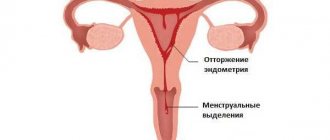A miscarriage may occur in the first weeks of pregnancy, but the woman may not know that she was pregnant. Miscarriage is a serious stress for the hormonal and immune systems of the female body.
Pregnancy failure (miscarriage) before the menstrual cycle is delayed usually occurs due to a disruption in the process of implantation of embryonic cells into the endometrial cavity at the very beginning of pregnancy. With such a failure, menstruation occurs with a slight delay or on time, so it is difficult for a woman to understand whether there was a miscarriage. Moreover, all signs of pregnancy that may have already appeared are most often mistaken by a woman for symptoms of ordinary premenstrual syndrome. No one knows exactly how often miscarriages occur in the first or second week of pregnancy. However, whether there was a miscarriage can still be determined by some symptoms.
Miscarriage or menstruation
It is not easy to distinguish between the loss of a child and menstruation, since the nature of the discharge depends on the woman’s health and her lifestyle. Menstrual bleeding that begins on time makes one think that fertilization has not occurred. But pay attention to the calendar: if there was a delay of only a couple of days, this may not indicate an irregular cycle, but a spontaneous termination of pregnancy. During such periods, a woman suffers from pain more than usual.
If a spontaneous abortion occurs, the menstrual cycle is delayed, lengthened, and the volume and color of the discharge changes. Upon careful examination, elements of the fertilized egg are revealed.
You can distinguish the fertilized egg from other secretions by density and size. The appearance of a large mucous-blood clot may indicate an interrupted pregnancy.
Women rarely pay attention to this, so at home it is almost impossible to understand that a miscarriage has occurred.
If menstruation does not come on time, and unusual pain is noted in the lower third of the abdomen, a spontaneous abortion is likely to occur in the lumbar region. In a situation where a woman regularly suffers from pain during menstruation, it will be quite difficult to recognize a spontaneous miscarriage.
Determine exactly what is happening using one of two methods:
- Ultrasound;
- hCG analysis.
With an ultrasound examination, the doctor sees whether a fertilized egg is present in the uterus, checks the heartbeat, and monitors the degree of development of the embryo. The gynecologist will tell you exactly whether there is a high probability of losing the fetus. Ultrasound allows you to assess the condition of the cervix and the organ itself.
The first days after fertilization, the egg is so small that even ultrasound will not provide accurate information. A blood test for human chorionic gonadotropin comes to the rescue. This is the name given to the hormone produced by the female body during pregnancy. If a miscarriage occurs, the level of hCG in the blood remains for 5-7 days. The concentration of hCG in the event of a threatened miscarriage or an ongoing abortion will be lower than it should be at this stage of pregnancy.
If a gynecological examination shows that the cervix is open, the pregnancy cannot be maintained. If the cervix is closed and the embryo is alive (according to ultrasound), there is a chance that the pregnancy will continue. For this purpose, hormonal therapy, antispasmodics and other drugs are prescribed.
How to find out if a miscarriage has occurred
It is almost impossible to distinguish spontaneous abortion from menstruation based on external symptoms, especially if it occurs at a very early stage. Ultrasound examination in this case is also uninformative - for the device these processes look the same. The size of the fertilized egg at this period is still too small and does not allow it to be seen.
Determining whether a miscarriage or menstruation is the cause of bleeding is available thanks to the development of laboratory diagnostics.
There is a sign that allows you to find out with a high degree of certainty whether there was a pregnancy. It is indicated by the presence of a special hormone in the woman’s blood and urine – human chorionic gonadotropin (hCG).
It is on its detection that the action of all tests is based - the second strip appears if there is a sufficient concentration of this substance in the urine.
The hCG hormone begins to be produced approximately a week after implantation of a fertilized egg into the endometrium, its content in the blood rapidly increases until 11-12 weeks, and then begins to decrease. A high concentration of human chorionic gonadotropin in a woman’s blood and urine persists for several days after a miscarriage. This is what makes it possible to distinguish it from menstruation.
Therefore, the most accessible way to recognize an early miscarriage is to take a pregnancy test. When the bleeding is just menstruation, only one line will appear. And if it is caused by spontaneous abortion, the second one will be clearly or faintly visible.
A more reliable method is to determine hCG using a special blood test. A reliable result can be obtained within about a week after the start of bleeding. After a miscarriage, the level of the hormone decreases, and after a few days it is already difficult to detect.
If your period is late, it makes sense to take a test right away. Modern means detect an “interesting situation” on the very first day of delay. If the result is positive, if bleeding begins, it will be clear that the cause is not due to menstruation. Knowing this, you can promptly seek medical help.
In addition, one of the ways to recognize conception is to determine basal temperature and keep a graph of indicators . In the case of fertilization of the egg, the value increases noticeably, which also makes it possible with some degree of confidence to distinguish an interrupted pregnancy from menstruation in the event of bleeding.
Symptoms
For a barely conceived fetus, the most dangerous period is the time when menstruation should have occurred, that is, 2-3 weeks of development. A miscarriage at such an early stage goes unnoticed, without specific sensations. The first sign is bloody discharge, which differs slightly from menstrual discharge.
Characteristic symptoms:
- pain in the lower back, sacrum, coccyx;
- spasms in the lower third of the abdomen;
- discharge that occurs after a slight delay in menstruation;
- the appearance of blood clots and mucus.
It happens that bleeding does not open during a frozen pregnancy. The woman does not notice any discharge, she is not tormented by pain, and no rejection occurs. The condition is life-threatening, as there is a high risk of infection of the uterus. Freezing of the fetus in the mother's womb is associated with a high probability of blood poisoning. A timely ultrasound allows you to diagnose the condition and take timely measures.
Rejection of the fetus during a frozen pregnancy can occur, but this is rare, symptoms:
- spasms, sharp pain in the lower third of the abdomen;
- elevated temperature;
- heavy bleeding.
The volume and color of discharge during a frozen pregnancy varies.
Classification
Menstruation and miscarriage are different physiological processes, but they are accompanied by similar symptoms.
Menstrual bleeding is part of the natural female cycle. Every month the body prepares to conceive a child; this process is controlled by hormones. The internal cavity of the uterus is lined with a special layer of endometrium, designed to secure the fertilized egg and subsequently nourish the embryo. If fertilization of the egg does not occur (or there is no ovulation), the endometrium dies and is removed from the uterus along with the remnants of small blood vessels formed during the cycle. Outwardly, it looks like bloody discharge from the vagina, and is often accompanied by pain. This process is called menstruation (or menstruation).
Miscarriage is a term that refers to the spontaneous termination of pregnancy in the early stages (before 22 weeks). If conception occurred recently, then externally, fetal rejection is almost no different from normal menstruation.
It is also accompanied by pain and bleeding. The fertilized egg is still too small to be seen among the blood and clots.
Miscarriage occurs for various reasons; for successful conception and pregnancy they must be identified and eliminated.
There are practically no visual differences between early miscarriage and menstruation, but methods for recognizing them still exist.
Discharge during miscarriage
Uterine bleeding is the most dangerous symptom of a miscarriage. The discharge is weak at first, then intensifies. If you visit a doctor at this time, there is a chance to save the fetus.
The condition worsens without any prerequisites; suddenly, many factors can provoke a miscarriage. If you observe pieces of tissue similar to menstrual discharge, you should urgently visit a doctor.
Practice shows that in 80% of cases, the death of the fetus occurs long before its particles are removed from the female body. For this reason, pieces of tissue and elements of the fertilized egg may be observed, that is, the uterus is gradually cleared. If complete rejection occurs, a grayish bubble is found among the blood-containing discharge. White particles are less commonly recorded. Pain and bleeding stop 2-3 days after cleansing the body.
If the uterus was cleansed without medications or medical procedures, there will be no need for treatment. If an ultrasound shows that elements of the fetus or placenta remain in the body, these tissues are urgently removed to avoid infection.
After a spontaneous abortion, menstruation is expected in 1-1.5 months.
If a miscarriage caused by the body’s unpreparedness for pregnancy occurs at 7-8 weeks of pregnancy, an egg similar in size to a quail’s is found in the discharge. The fruit is gray in color with reddish veins.
If rejection occurs at 8-12 weeks, the discharge contains a formed egg, close in size to a chicken egg, somewhat elongated. The fruit is flesh-colored, with veins.
At an even later stage, the fetus leaves the uterus with fragments of the placenta.
How does a miscarriage happen?
A miscarriage is a rather long process that can take several days. The threat of miscarriage in many cases is treated successfully - modern doctors know how to prevent miscarriage, although this is not worth doing in every situation, because the body usually knows better whether to get rid of the fetus. But many women cannot get pregnant for years, and it is very important for them to keep the child. Therefore, at the first signs of a miscarriage, you need to go to the hospital, otherwise it will be too late - often by the time the active stage of abortion begins, the embryo has long ceased to function.
When there is a threat of miscarriage, the cervix remains closed, the fetus continues to develop, although minor abdominal pain or discomfort in the lower back and uterine bleeding appear. If this process is not stopped, the fetus may die, as a result it will peel off from the walls of the uterus. Once the cervix dilates and the fetal membrane ruptures, miscarriage is inevitable, although it may be incomplete if the embryo or its particles remain in the uterus. In a complete miscarriage, the fetus is completely expelled, the bleeding stops, and the pain stops.
Causes
A miscarriage indicates that the body is not ready to bear a fetus. But pathology does not put an end to motherhood. Supportive therapy, regular visits to an experienced gynecologist and attention to the body allow a woman to experience the joy of giving birth to a child, even in a difficult case.
Risk factors:
- physical exercise;
- emotional stress;
- abnormal development of the genital organs;
- previous abortions and miscarriages;
- hormonal disbalance;
- pathology of the hemostatic system;
- infections;
- diseases of the uterus and appendages;
- abnormalities of fetal development.
The beginning of pregnancy is a difficult period for the female body; various factors cause a sharp reaction that provokes rejection of the fetus. Being pregnant and having experienced an abortion without complications, they can easily bear one or more children in the future. Knowing in advance what kind of discharge women have during spontaneous miscarriage, the expectant mother can determine that there is cause for concern.
What is a missed miscarriage?
A miscarriage can happen in different ways - both with pronounced symptoms and with their complete absence. A pregnant woman does not suspect that the fetus inside her has frozen; she only complains of a deterioration in her general health or notices the disappearance of characteristic signs of pregnancy - morning sickness, lack of appetite, etc.
If, before fading, the pregnancy had a period during which there were fetal movements, they stop. During the examination, the gynecologist, when listening to the heartbeat, discovers its absence.
After attending an ultrasound, which confirmed the death of the fetus, the woman is given an abortion and the bleeding is stopped. Then she is offered to undergo a special test for hidden infections that could affect such an unfavorable pregnancy outcome.
If the test results confirm the presence of any disease, the husband should also undergo examination. Appropriate treatment is prescribed to both spouses.
- How does a miscarriage occur?
- What are the signs of miscarriage?
Do not be afraid!
Early fetal rejection indicates that something is wrong with the body. There is no reason to be upset: if the fetus had survived, development would most likely have gone wrong, and the child would have been born with disabilities or died during childbirth. Early miscarriage is an evolutionary mechanism that allows strong individuals to survive.
It is important to understand in time that what happened is not menstruation, but the discharge accompanying a miscarriage. This forces a woman to take care of her health and avoid a similar situation in the future. Once she realizes that a miscarriage has occurred in the early stages, the expectant mother is more attentive to herself, carefully monitors the symptoms, controls the discharge, knowing what to expect, what to fear, and what signals the normal course of pregnancy.
Is it possible to determine a miscarriage on your own?
The first warning signs, regardless of the course of pregnancy, are mild nagging pain in the lower abdomen. Subsequently, they acquire a cramping character and are accompanied by a copious amount of discharge, indicating detachment of the fertilized egg.
After its death and complete detachment, the woman may experience significant pain and bleeding. The woman cannot know whether parts of the fetus remain in the uterine cavity.
If a miscarriage occurs at home, and not in a “supported” clinic, you must urgently contact a gynecologist for an examination and ultrasound. Based on its results, you can find out whether procedures to cleanse the uterus are needed.
After a miscarriage, you should not immediately plan for another pregnancy. The interval between a miscarriage and a new conception must be at least 6 months, otherwise the woman may suffer the same fate.
Summing up
Noting the changes occurring in the body, the changing nature of the discharge, visit a doctor. In the early stages, pregnancy, even if the body is not ready for this, can be saved. If you have gynecological or hormonal diseases and preservation is impossible, do not panic - rejection of a non-viable fetus does not mean that you will not be able to give birth in the future.
If a woman has had a natural abortion, plan a new pregnancy in advance. In this case, they register with a gynecologist, undergo regular examinations and tests, and strictly follow the prescribed drug support program. This minimizes risks and allows you to carry and give birth to a healthy baby. You can plan a new pregnancy 3-6 months after a miscarriage and treatment.
Read
Also:
- Swimming in the sea during pregnancy: is it possible or not?
- Can menstruation occur during pregnancy: causes of discharge and how to distinguish
- What does placental abruption mean during pregnancy?
- Brown vaginal discharge: causes and treatment
- Uterine fibroids and pregnancy: is it possible to give birth?
- Is it possible to drink alcohol or coffee during menstruation?
Symptoms and causes of early miscarriage
According to statistics, every woman experiences an early miscarriage at least once during her life, mistaking it for normal menstruation. The symptoms and signs of these processes are almost identical. The reasons for terminating a pregnancy that has just begun are different:
- infectious and inflammatory diseases (gynecological or general);
- hormonal disorders;
- Rh conflict and other immunological factors;
- stress;
- improper fixation of the embryo in the uterus;
- high physical activity;
- taking medications, including herbal ones;
- genetic abnormalities in fetal development;
- bad habits, unhealthy diet, coffee abuse;
- sexual contact, trauma;
- intoxication;
- overweight or underweight;
- insufficient restoration of the uterus and the body as a whole after a previous birth, abortion or miscarriage.
Fetal rejection in the first weeks after conception usually does not pose a health threat, but there are exceptions.
No delay
If menstruation began exactly on time, there is a high probability of spontaneous abortion. You can understand that bleeding is the beginning of a miscarriage by a number of signs:
- severe cramping pain radiating to the lower back;
- brown color of blood, an abundance of clots in the discharge;
- positive pregnancy test.
Restoring health after a miscarriage
Naturally, many failed mothers experience a miscarriage very hard. This is a normal mental reaction. The only way out of the situation sometimes seems to be a speedy new conception. However, you should not do this in the near future, since the main task now is to restore your health. The next pregnancy can be planned no earlier than six months after a spontaneous abortion (some doctors even advise waiting one year). This will reduce the risk of another failure. In the meantime, a woman should take care of a reliable method of contraception.
You need to plan a new pregnancy after a miscarriage no earlier than six months, and during this time you should take reliable protection
It is very important to conduct a study of embryonic tissue and analyze the condition of the female body in order to find out the specific cause of the miscarriage (especially if it is not the first).
For at least a month after termination of pregnancy, a woman should abstain from sexual activity. Also during this period you should not overheat, visit the bathhouse and sauna, lift weights, or go to the gym.
A balanced diet, drinking regimen, and daily exposure to fresh air will help restore strength and improve health.
Many women are interested in the issue of the onset of their first period after a miscarriage. Typically, gynecologists call the period 21–35 days (including after cleansing). The individual characteristics of the female body play a role here. In any case, a delay of more than 35 days is a reason for an additional medical examination and ultrasound examination.
The first menstruation after a miscarriage is usually heavy, but there is no need to be alarmed. After one or two cycles everything should return to normal.
Psychological rehabilitation of women
Often an early miscarriage becomes a real stress for a woman, especially if the pregnancy was desired and planned. And if physiologically the body recovers from this event quite quickly, then psychological rehabilitation can take quite a long time.
Psychologists advise not to be ashamed of your emotions, not to hold back your tears: this way the psyche will recover faster after a loss. A woman should be able to grieve the loss of her baby for as long as she needs. Under no circumstances should you isolate yourself and look for those to blame for the loss of pregnancy, including yourself.
As soon as the bleeding stops, it is recommended to begin a medical examination: tests for infections, ultrasound, etc. These actions will distract you from gloomy thoughts.
During the recovery period, the support of loved ones is very important, especially a loving spouse, who will reassure his other half and instill in her faith in the future. After all, some failed mothers tend to isolate themselves from their partner and experience misfortune alone, not realizing that the husband can suffer just as much, simply by holding back his emotions within himself.
During the recovery period after a miscarriage, the support of loved ones is very important.
Other relatives and friends can also help. Finally, you can chat on the appropriate forum on the Internet with women who have experienced the same problem.
If you can’t cope with negative thoughts, then the way out of the situation is to contact a psychotherapist. You just need to find a specialist with whom you feel comfortable communicating. He will explain the meaning of what happened and give the necessary instructions. If necessary, the doctor will prescribe antidepressants.
If you can’t cope with the problem on your own, you can seek help from a psychotherapist.
Some women are helped to cope with the emotional trauma after a miscarriage by returning to work as soon as possible: there they are distracted from their worries. Others, on the contrary, need to stay at home more.
It should be remembered that physical activity promotes the production of the joy hormone. Of course, it should be moderate, especially in the first month. Even regular walking, cycling, dancing, and yoga will have a good effect. It’s great if a woman has some kind of hobby: doing what she loves also has a therapeutic effect.
How to avoid miscarriage
There are cases when a miscarriage can be prevented by prescribing timely and correct treatment, taking into account the causes and nature of the complications. In the event of a threatened miscarriage, a representative of the fairer sex undergoes the necessary medical examination and takes prescribed medications. These include vitamins, sedatives and painkillers, and hormones. It should be noted that pregnant women must remain in bed.
During this period, it is strictly forbidden to engage in sexual activity. If bloody discharge occurs, a woman expecting a child is sent to the pathology department to maintain the pregnancy and carefully monitor the health of the mother and fetus. Compliance with these measures very often leads to the birth of a healthy baby.
A miscarriage may occur in the first weeks of pregnancy, but the woman may not know that she was pregnant. Miscarriage is a serious stress for the hormonal and immune systems of the female body. Pregnancy failure (miscarriage) before the menstrual cycle is delayed usually occurs due to a disruption in the process of implantation of embryonic cells into the endometrial cavity at the very beginning of pregnancy. With such a failure, menstruation occurs with a slight delay or on time, so it is difficult for a woman to understand whether there was a miscarriage. Moreover, all signs of pregnancy that may have already appeared are most often mistaken by a woman for symptoms of ordinary premenstrual syndrome. No one knows exactly how often miscarriages occur in the first or second week of pregnancy. However, whether there was a miscarriage can still be determined by some symptoms.











